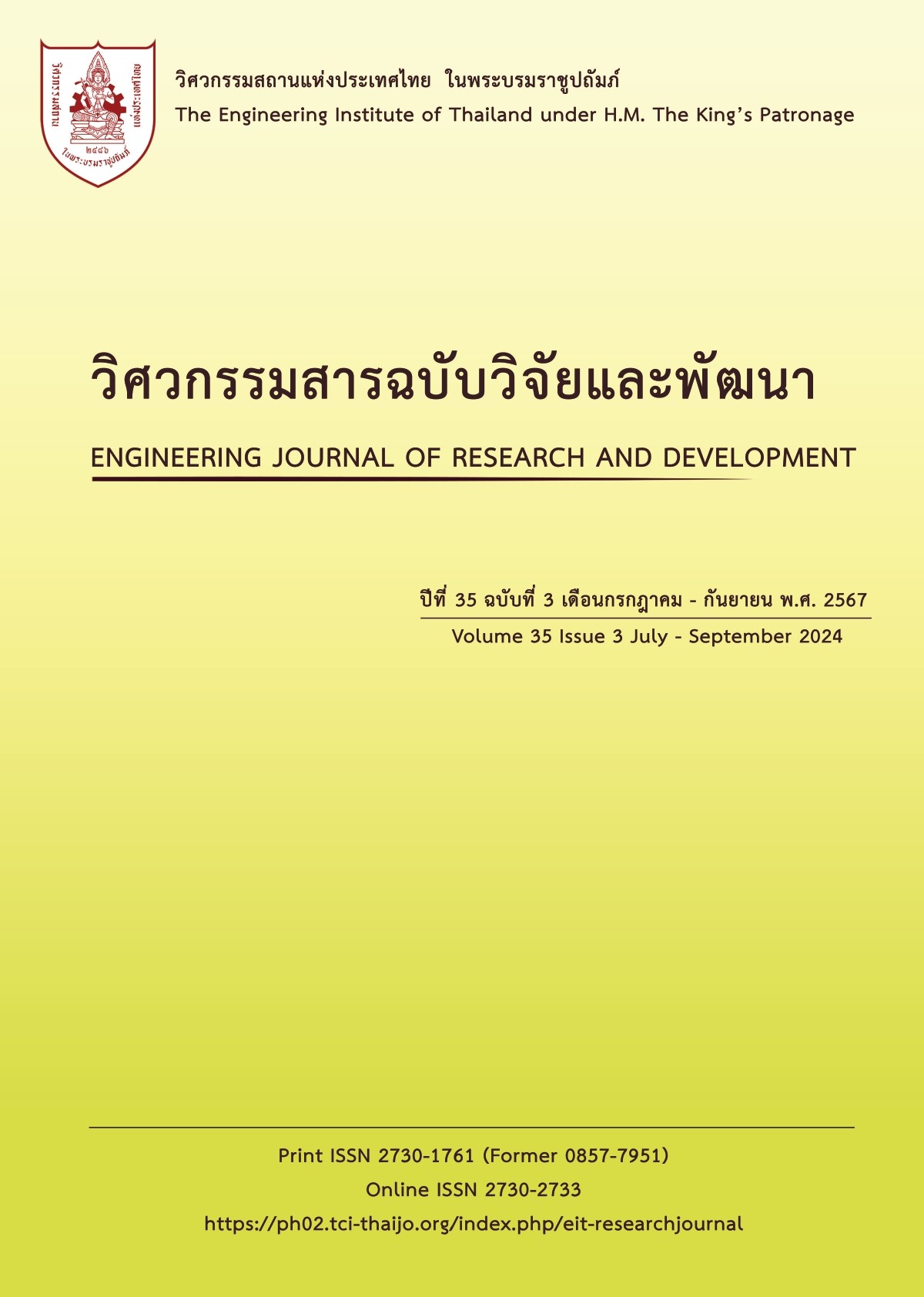พฤติกรรมการรับแรงดัดของคานคอนกรีตเสริมเหล็กที่เสริมกำลังด้วยแท่งพอลิเมอร์เสริมเส้นใยแก้ว ระบบอัดแรงภายนอก
Main Article Content
บทคัดย่อ
วิธีการเสริมกำลังโดยวิธีอัดแรงภายนอกเป็นวิธีที่มีประสิทธิภาพในการเสริมกำลังของโครงสร้างคอนกรีตเสริมเหล็ก ในปัจจุบันการเสริมกำลังด้วยแท่งพอลิเมอร์เสริมเส้นใยมาทดแทนลวดเหล็กอัดแรง เพื่อหลีกเลี่ยงปัญหาการกัดกร่อน และเพิ่มความทนทาน งานวิจัยนี้มีวัตถุประสงค์เพื่อศึกษาพฤติกรรมการรับแรงดัดของคานคอนกรีตที่เสริมกำลังด้วยแท่งพอลิเมอร์เสริมเส้นใยแก้วระบบอัดแรงภายนอก ตัวแปรที่ทำการศึกษาประกอบด้วย อัตราส่วนร้อยละที่เหมาะสมกับการอัดแรง การทดสอบประกอบด้วยคานตัวอย่างจำนวน 3 ตัวอย่าง ประกอบด้วยคานตัวอย่างควบคุม และอีกสองคานที่ได้รับเสริมกำลังด้วยแท่งพอลิเมอร์เสริมเส้นใยแก้ว โดยขนาดของคานคอนกรีตเท่ากับ 150 300 2500 มิลลิเมตร สำหรับคานที่เสริมกำลังใช้การอัดแรงร้อยละ 20 และ 40 ของแรงประลัยสูงสุดของพอลิเมอร์เสริมเส้นใยแก้ว สำหรับพฤติกรรมการทดสอบประกอบด้วย ความสัมพันธ์ระหว่างแรงกระทำและ
การแอ่นตัว การกระจายตัวของรอยร้าว และลักษณะการวิบัติจากผลการทดสอบพบว่า คานที่ได้รับการเสริมกำลังสามารถรับกำลังรับแรงดัดได้เพิ่มขึ้นร้อยละ 41 การเสริมระบบอัดแรงภายนอกสามารถเพิ่มแรงกระทำที่ทำให้เกิดรอยร้าวเริ่มต้นร้อยละ 86
Article Details

This work is licensed under a Creative Commons Attribution-NonCommercial-NoDerivatives 4.0 International License.
บทความที่ได้รับการตีพิมพ์เป็นลิขสิทธิ์ของวารสารวิศวกรรมสารฉบับวิจัยและพัฒนา วิศวกรรมสถานแห่งประเทศไทย ในพระบรมราชูปถัมภ์
References
Hussain, M. et al. Flexural behavior of precracked reinforced concrete beams strengthened externally by steel plates. Structural Journal, 1995, 92 (1), pp. 14-23.
Aykac, S. et al. Strengthening and repair of reinforced concrete beams using external steel plates. Journal of Structural Engineering, 2013, 139 (6), pp. 929-939.
Saribiyik, A. and Caglar, N. Flexural strengthening of RC Beams with low-strength concrete using GFRP and CFRP. Struct. Eng. Mech, 2016, 58 (5), pp. 825-845.
Al-Shamayleh, R. Al-Saoud, H. and Alqam, M. Shear and flexural strengthening of reinforced concrete beams with variable compressive strength values using externally bonded carbon fiber plates. Results in Engineering, 2022, 14, 100427.
Al-zu’bi, H. Abdel-Jaber, M. T. and Katkhuda, H. Flexural strengthening of reinforced concrete beams with variable compressive strength using near-surface mounted carbon-fiber-reinforced polymer strips [NSM-CFRP]. Fibers, 2022, 10 (10), 86.
Sokairge, H. Elgabbas, F. and Elshafie, H. Structural behavior of RC beams strengthened with prestressed near surface mounted technique using basalt FRP bars. Engineering Structures, 2022, 250, 113489.
Said, A. I. et al. Strengthening Behavior of Reinforced Concrete T-Beams Using External Prestress Tendons. Applied Research Journal, 2016, 2 (11).
Gao, D., Fang, D., You, P., Chen, G., & Tang, J. Flexural behavior of reinforced concrete one-way slabs strengthened via external post-tensioned FRP tendons. Engineering Structures, 2020, 216, 110718.
Yang, J. Q., Feng, P., Liu, B., Wang, H., Zhao, W., & Hu, L. Strengthening RC beams with mid-span supporting prestressed CFRP plates: An experimental investigation. Engineering Structures,2022, 272, 115022.
Du, J. S., Yang, D., Ng, P. L., & Au, F. T. Response of concrete beams partially prestressed with external unbonded carbon fiber-reinforced polymer tendons. Advanced Materials Research, 2011, 150, 344-349.
Serega, S., & Faustmann, D. H. Flexural strengthening of reinforced concrete beams using external tendons. Engineering Structures, 2022, 252, 113277.
Aravinthan T, Witchukreangkrai E, Mutsuyoshi H. Flexural behavior of twospan continuous prestressed concrete girders with highly eccentric external tendons. ACI Struct J, 2005,102 (3) pp. 402–11.
Aparicio, A. C., Ramos, G., & Casas, J. R. Testing of externally prestressed concrete beams. Engineering Structures, 2002, 24 (1), pp. 73-84.
Pisani, M. A. A numerical survey on the behavior of beams pre-stressed with FRP cables. Construction and Building Materials, 1998, 12 (4), pp. 221-232.
Ghallab, A., & Beeby, A. W. Factors affecting the external prestressing stress in externally strengthened prestressed concrete beams. Cement and Concrete Composites, 2005, 27 (9-10), pp. 945-957.
Lou, T., Lopes, S. M., & Lopes, A. V. Factors affecting moment redistribution at ultimate in continuous beams prestressed with external CFRP tendons. Composites Part B: Engineering, 2014, 66, pp. 136-146.
Lou, T., Lopes, S. M., & Lopes, A. V. Numerical analysis of behavior of concrete beams with external FRP tendons. Construction and Building Materials, 2012, 35, pp. 970-978.
Pisani, M. A. A numerical survey on the behavior of beams pre-stressed with FRP cables. Construction and Building Materials, 1998, 12 (4), pp. 221-232.
ASTM A615-20. Standard specification for deformed and plain carbon-steel bars for concrete reinforcement. West Conshohocken, 2020.
ASTM D7205. Standard test method for tensile properties of fiber reinforced polymer matrix composite bars. Pa: ASTM Int West Conshohocken, 2016.
ACI Committee 440. Guide for the Design and Construction of Externally Bonded FRP Systems for Strengthening Concrete Structures. Farmington: American Concrete Institute, 2008.
Naaman, A. E. Partial Prestressing in the Rehabilitation of Concrete Bridges. Proceedings of U.S.-European Workshop on Bridge Evaluation, Repair and Rehabilitation, 1987, pp. 392-406.
Naaman, A. E. Stresses in Unbonded Prestressing Tendons at Ultimate: Recommendation. ACI Structural Journal, 2002, pp. 518-529.
BS8110, B. S. Structural use of concrete, part 1: Code of practice for design and construction. British Standards Institution, 1997.
JGJ92-2004. Technical specification for unbonded prestressed concrete structures. China Academy of Building Research, 2004.
Ng, C. K. Flexural behavior of externally prestressed beams. Part I: Analytical model. Engineering Structures, 2006, 609-621.

